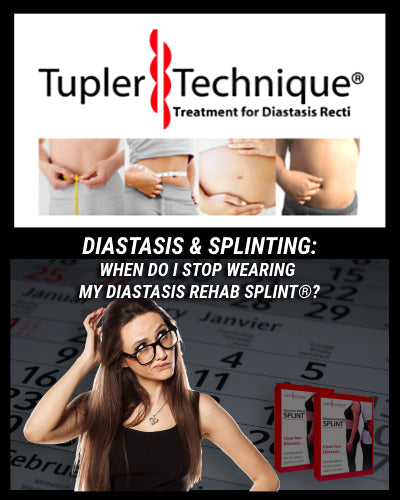This is a common question that I get asked all the time! The answer is “as long as it takes to close your diastasis recti .” Your connective tissue needs to be strong enough to hold your muscles together. How long it takes to close your diastasis depends on your commitment to all 4 steps of the program and the severity of your diastasis.
Here is why - your outermost abdominal muscles need to be close together to do their job of supporting your back and internal organs . When your muscles separate, the tissue joining them stretches sideways and becomes thin and weak. Thin and weak connective tissue cannot do the work of supporting your back and organs causing a slew of problems like back, hip, umbilical hernia, poor posture, GI issues such as bloating after eating and constipation and pelvic floor problems.
The abdominal muscles have to be closely positioned together to function properly and support your back and organs. Taking the stretch off your “stretched out” connective tissue by re-positioning it to a narrow position and continuously keeping it in that position will allow it to heal correctly.

Protecting your connective tissue from getting stretched either in a sideways or forwards direction is essential. That is why for the first six weeks of the program we do not want you to do any sporting activities or exercise classes or workouts. Cardio exercises like walking outside, walking on an incline on a treadmill, using an upright stationary bike or the Elliptical machine can still be done but there should be no running or jumping. Then in week six after you have developed transverse muscle strength and awareness you need to do a diastasis safe exercise routine so you don’t undo all the gains you have made in the first six weeks.
You can strengthen your transverse muscle and the connective tissue with the Tupler Technique® exercises.
The program progresses over eighteen weeks. However it does not end at 18 weeks and it is possible you may not close your diastasis within 18 weeks. Even when you close your diastasis, continuing to do the exercises is necessary to keep it closed. Because you have a weak spot in your connective tissue at your belly button you can always separate your abdominal muscles again by putting force on this tissue. This is a program you will want to do the rest of your life because of how great it makes you look and feel. You will not believe how much stronger you will feel when your muscles are in the right position. Close together! This program is not a fad.

If you have an umbilical hernia or the “half football like bulge” when you lift your shoulders off the floor you have a severe diastasis recti and it may take up to 9 months or over a year to close your diastasis. You will need to use two hands to check your diastasis when you have a severe diastasis recti . However, you will see the healing process working within three weeks. That is why it is so important to take photos of your belly from the front and the side. When you see the changes you will be motivated to continue the program.
Diastasis Recti Splint For your Mummy Tummy
Many people think that they can stop wearing it after six weeks or after 18 weeks. This is not true.
The Tupler Technique® is all about healing the connective tissue. Wearing the splint is about putting the connective tissue in a better “position” to heal. This has to be in this narrow position ALL the time. It is similar to the process of healing a broken bone. The cast continuously keeps the bones in the proper position to heal. The difference is that just wearing the splint will not close your diastasis. You must do the other 3 steps of the program. The Tupler Technique® exercises will create a microcurrent of electricity that remodels and helps heal the connective tissue Preventing intra-abdominal force on the connective tissue is also part of allowing the connective tissue to heal. That is another reason why it is so important to do the exercises to strengthen the transverse muscle. You use this muscle with every move you make. So it needs to be strong so you can engage it when doing activities of daily living (getting up and down) with body functions (sneezing, coughing, going to the bathroom) and then in week six while exercising.
How will you know it is closed? If you have been checking yourself from the start you will feel the connective tissue becoming shallower and stronger. As the connective tissue becomes shallower the muscles will come together. The shallower the connective tissue the stronger it becomes. When you put your fingers in your belly button and your fingers cannot go very deep you will know it is closed!
Watch this testimonial of a client who went through my program:
Please remember that you are ALWAYS at risk of opening your diastasis after you have closed it by stretching your connective tissue either in a forwards or sideways direction. That is why your transverse muscle must always be your best friend!
Learn more about the different types of Tupler Technique® Programs here and if you are interested to know which type of program suits you click this link.




